Ultimate Guide To Change Management: Making Your Organization Thrive In 2024
In today's corporate world, change is inevitable. The majority of change initiatives, however, fail to succeed. This is largely the result of poor change management.
Change— bought in too much and too fast— causes employees to grow overwhelmed. When this happens, the consequences are rather grave. From lower employee engagement to higher turnover, poorly managed change processes can cause organizational outcomes to dip.
Leaders must acknowledge that the capacity for change is limited — especially in the short term. In fact, most companies fail to engage in effective change management.
A Harvard Business School study reported that almost 70% of all change initiatives fail.
Change is costly. But if organizations do not evolve, survival becomes hard.
The outcomes can be terrible if you are a leader forced into leading a change initiative without knowing what you are doing. That is why it is critical for today's leaders to understand the fundamentals of change management and how to navigate it.
But first, let's start with:
What Is Change Management?

Change management is a system that assists an organization in anticipating, preparing for, and dealing with any new shift that can impact the organization's operations and workflows.
While change can be planned or unplanned, leaders must have a change management strategy in place that is ready to go. A company's key stakeholders— including its employees, clients, and bottom line— are hugely impacted by how leaders handle change.
Benefits Of Change Management
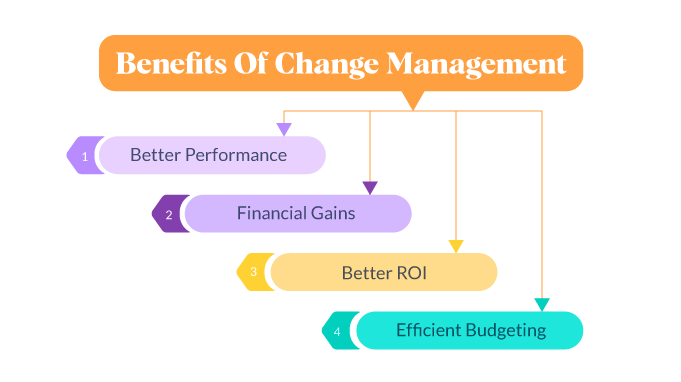
Ask any leader if "change management" is an easy task to take on, and they will undoubtedly respond with "No!" Despite this, change management remains one of those initiatives that high-innovation companies can't seem to ditch. Here's why:
1. Better Performance
According to BCG, businesses that focus on the cultural aspect of change are 5 times more likely to attain breakthrough performance than those that overlook it.
2. Financial Gains
A Towers Watson study highlighted that companies are 2.5 times more likely to financially outperform their peers when a good change management practice is in place.
3. Better ROI
McKinsey revealed that 143% of the expected ROI is achieved from organizations with an effective change management program. Meanwhile, organizations with little or no change management only reached 35% of the expected ROI.
4. Efficient Budgeting
A Prosci study revealed that 81% of projects implementing effective change management practices meet the allocated budget, while the ones that don't show a negative fiscal impact.
Types Of Organizational Changes

As a change leader, you first need to understand the scope of the change. Then and only then can you successfully implement a change management strategy.
When we talk about organizational change, it comes in different forms and sizes. Every change— whether it be a rebranding, layoffs, mergers & acquisitions, or the appointment of a new CEO— is unique to the organization.
But fortunately for us, the majority of changes fall into one of these broad categories:
1. Organization-wide Change
Big-scale changes that impact every employee of the organization are called organizational-wide changes. These changes require in-depth planning and strategizing to ensure that the implementation is successful.
2. Transformational Change
Transformational changes are focused on a company's organizational strategy. Companies that are best suited to withstand a rapid change in their industry are agile, adaptable, and prepared to transform their game plans when needed.
3. Personnel Change
Personnel changes occur when a company experiences specific changes that impact the size of its staff, such as downsizing, upsizing, or mass resignations.
4. Unplanned Change
Unplanned changes are unpredictable events that affect an organization's workflow. The best way for change leaders to deal with unexpected changes is to have an emergency change strategy that will allow the organization to get a head start when the change occurs.
5. Remedial Change
Change leaders introduce remedial changes to remedy specific company issues, such as poor performance or inability to meet the bottom line.
The 10 Principles Of Change Management
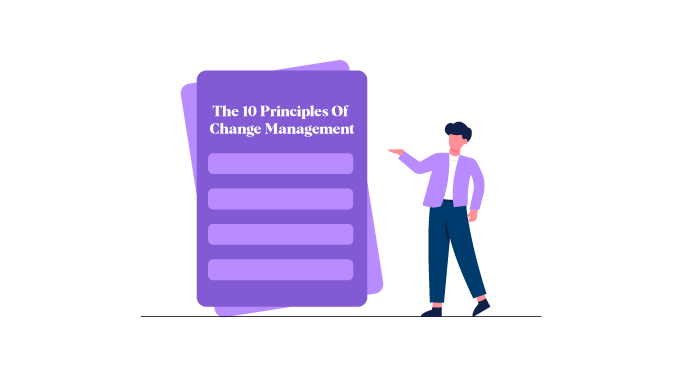
The change management process can be boiled down to 10 basic guiding principles:
1. Address the "human side" systematically
A big part of an organizational change is how it will affect its people.
It is important to design a formal strategy for managing change early on and to make frequent adjustments as the change spreads across the company.
Start by engaging the leadership team first, then move on to key stakeholders and leaders.
Arne Sorenson, the CEO of Marriott International, received widespread praise for an emotional six-minute video he posted in March 2020 in which he discussed the company's steep losses. He explained that he would forego his salary for the rest of the year and that the pay of his executive team would be cut by half. It resulted in a massive outpouring of support, with him being described as "inspiring," "vulnerable," and "authentic."
2. Start at the top
Everyone finds change to be disturbing by nature.
When a change is imminent, all eyes will turn to the CEO and the leadership team for strength, support, and direction.
Thus, to challenge and inspire the rest of the organization, the leaders themselves must first adopt the new strategies.
3. Involve every layer
Change initiatives shift from strategizing, and goal-setting, to putting these goals into action. These initiatives affect the workforce at many levels along the road.
To ensure that change is implemented fairly, it is crucial to identify potential leaders across levels and assign them the design and implementation tasks.
4. Articulate the formal case for change.
People are naturally logical, so they will have many questions about the change.
- Is the change truly required?
- Is the business heading in the right direction?
- Do they wish to make a personal commitment to bringing about change?
Naturally, they will look to the leadership for answers to such questions. To get your team on board with what the leadership team is planning, two really helpful methods are creating a formal case for change and a documented vision statement.
5. Create ownership
Major change initiatives need idealistic leaders who can rally the workforce behind the change.
Leaders must be willing to accept responsibility for bringing about change in all areas where they have influence or control.
6. Prepare for the unexpected.
No change initiative is ever carried out exactly as intended.
People react in unexpected ways. Barriers fall away. The external environment shifts.
Thus, to effectively manage change, it is necessary to constantly assess its impact and the organization's ability to adapt.
7. Effectively communicate the message.
The most effective change initiatives amplify key messages by providing timely, frequent feedback that is uplifting and actionable.
8. Assess the cultural landscape.
As they cascade downward, the consequences of effective change initiatives become more rapid and intense. Therefore, it is crucial that leaders are aware of and consider culture and behavior at every level of the company.
9. Address culture explicitly.
Once the culture is established, it should be acknowledged as thoroughly as any other area in a change program.
Leaders must clearly explain the culture and underlying practices that best support the new way of doing business.
Find opportunities to reward and model those habits as well, to make sure they persist.
10. Speak to the individual.
Change is both an organizational journey and a very personal one.
People need to be involved in the change process because they react to what they see and hear around them.
Thus, it is important for team managers to be as open and transparent as they can.
Popular Change Management Models
One of the key things to understand about change is that it is gradual and happens over stages.
Successful change leaders understand this and always base their change initiatives on research-backed frameworks.
Here are two popular change management models that will help you lead and guide your people successfully through a period of change:
1. ADKAR Model
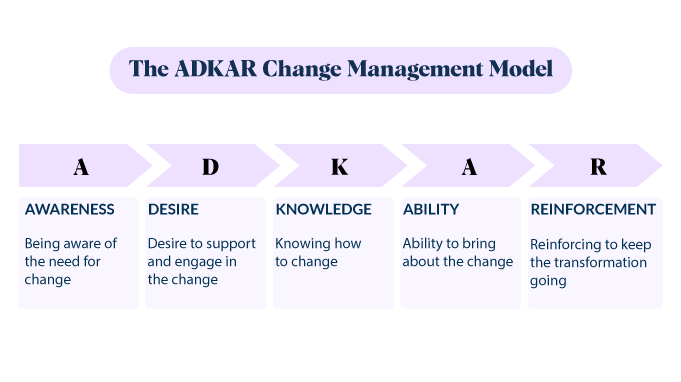
The ADKAR model of change, developed by the US research organization Prosci, is a practical solution to effective change management. The model is simple to learn, logical and focuses on the actions and outcomes required for change.
Many change management initiatives concentrate on the steps required for organizational change. But ADKAR takes it a step further. It emphasizes that organizational change occurs only when each employee can successfully transition.
This model, developed by Jeff Hiatt, focuses on 5 actions and outcomes necessary for successful individual change. By extension, it impacts the success of the organizational change.
- A: Awareness of the need for change.
- D: Desire to support and participate in the change.
- K: Knowledge of how to change.
- A: Ability to implement the change.
- R: Reinforcement to sustain the change.
2. Kottler's 8-step Change Model
John Kotter developed the Kotter 8-step change model in response to a survey of more than 100 companies going through change. More than the changes themselves, it emphasizes the people going through that change.
Establish a sense of urgency.
Create a sense of urgency around the need for change. This can start a domino effect that gets things moving.
Create strong collaborative teams.
It often takes strong leadership to persuade people that change is required. You must lead change; just managing it won't cut it.
Develop a change-oriented vision.
A clear vision might make it easier for your people to grasp the motivations behind your goals.
Communicate to gain support.
Your success is defined by what you do with your vision after you've created it. Other daily communications within the company will likely be in a fierce contest with your change message. So you need to communicate it clearly and frequently. Try to ingrain the change message in everything you do.
Eliminate barriers and empower.
Set the stage for change and keep an eye out for roadblocks. Removing roadblocks can empower the people you need to carry out your vision and help the change move forward.
Prepare for and enable short-term wins.
Nothing motivates like success. Early in the change process, give your company a taste of victory. You'll need outcomes that your staff can see quickly. Without this, skeptics and cynics might impede your progress.
Build on the change.
The work necessary for long-term change doesn't stop with quick wins. With each success, you have the chance to build on what worked well and pinpoint areas for improvement.
Make the changes stick.
Make ongoing efforts to guarantee that the change is visible in all areas of your company. It will help to solidify the change in your company's culture.
How To Lead A Successful Change Management Initiative?
According to John Kotter, only 30% of organizational change initiatives are successful. A change initiative's desired objectives must be fully achieved to be considered successful.
Each of the phases highlighted below is a step-by-step process of handling change effectively.
1. Make a Strong Case for Change

People need reasons to explain the need for change. A case for change is a tool or collection of evidence that assists change managers in communicating the:
- Motives for the change
- The dangers of not changing
Making an effort to create a compelling case for change will pay off in the long run. It guarantees that all stakeholders know your project's what, why, and how.
Step 1: Begin with the problem or opportunity.
Start by jotting down why you asked (or were nominated) to initiate the change. Is it due to:
- An adverse event?
- A service that isn't working as well or efficiently any longer?
- Emerging proof of a more effective technique?
Think about the significance of this for your managers and other employees. Find out what the strategic plan is for your company. Then, analyze how executing this change will contribute to the company's bottom line.
Step 2: Gather the available evidence
Establish the need for the change initiative with credible reasoning. Examine the records of past change initiatives that have been completed and their results. Use industry-based data to identify barriers. Verify if there is any predictive data that could be useful for analysis.
Step 3: Determine the effects
Make a case for why the company will greatly benefit from going ahead with the change initiative. Use your evidence to predict or depict the outcomes if nothing is done or the existing situation worsens.
Step 4: Engage stakeholders
Once you've documented your case for change, think of creative ways to present your data to various audiences. A compelling case for change needs to address diverse viewpoints and motivations for change. Executives may want to see a strategic plan, whereas managers may be more concerned with how the change would affect KPIs.
2. Compelling Vision

A change vision is related to, but distinct from, your case for change. The change vision is intended to guide everyone, especially those who will be impacted by the change. Meanwhile, the case for change serves as a high-level overview to guide the project.
A compelling future vision is essential for any change project because it:
- Provide employees with a strong reason to embrace the change.
- Presents the basic details they need to understand the change to them.
- Acts as positive reinforcement, which they can cling to for support when the change is challenging.
Step 1: Form a group to develop the vision.
Assemble a small committee to develop the change vision to ensure it strikes a chord with a wide audience. Members of the committee should include some formal or informal leaders who will be impacted by the change to ensure that the case for change aligns with their expectations.
Step 2: Develop a first draft of the vision.
When creating the change vision, keep the following points in mind:
- Purpose: Explain why we need to do this and why the change is necessary.
- Picture: Envision what the future will look like.
- Plan: How we plan on getting there.
- Part: How you and your team will contribute to the success of the change.
Step 3: Test with key stakeholders and refine.
Check if the stakeholders who didn't get involved in its development agree with the vision. If confidentiality is critical, limit your test to a small group of senior executives. If there are significant changes, revise your proposal and notify the key stakeholders.
Step 4: Adapt to diverse audiences
Once you've finalized the draught of the change vision, tailor it to your target audiences. Speak with a representative from each audience to learn more about:
- What will your target audience appreciate about the change?
- What could they be nervous about?
- What matters to your target audience?
- Which success stories from the past can they relate to?
3. Communication

Change fatigue occurs because most companies impose change on people without informing them or letting them engage in the process.
If people don't know about and understand change beforehand, they can't prepare for it or implement it. People need to know change is coming, and they need to be able to communicate their thoughts and questions about it.
Your organization's needs will determine how far in advance you must notify everyone about the change.
The Change Communications Plan is a systematic approach to keeping key stakeholders up to date throughout the lifecycle of a change project. These communications are used to raise awareness and provide critical information to keep stakeholders informed.
It can be difficult to communicate a change. There may be multiple stakeholders with varying interests, necessitating different message framing. For this reason, when drafting the Change Communications Plan, here are the determinants to keep in mind:
- The audience (who)
- The messaging (what)
- The communication delivery method (how)
4. Identify Barriers

Undoubtedly, a change initiative can elicit emotions and worries that fuel pushback. But if you are aware of these common barriers, you can come up with solutions to go around them and speed up the process of significant change.
Logical and Rational Barriers
Logical barriers are the most obvious ones that can delay the change down. The secret to overcoming logical obstacles is to involve some key employees and executives in the planning process. The majority of the time, employees are in charge of managing daily operations. They are, therefore, the prime choices to identify certain obvious obstacles.
Psychological Barriers
These sorts of resistance frequently have an emotional or mental basis. Employees could fear the unknown, distrust management, or think their security needs are in danger. Although management may believe there is no reason for these sentiments, employees see them as perfectly reasonable.
Sociological Barriers
You must appropriately take social values into account because they heavily impact the work environment. Sociological resistance occurs when change is perceived as a threat to the team's interests, standards, and values. Workplace friendships and relationships can be strongly disrupted by change.
5. Manage Resistance

The strategies listed below can assist employees in overcoming their aversion to change.
Step 1: Communicate
Transparency is critical to your credibility. Explain to your employees the necessity of the change. Be clear about how they will be impacted. Set aside time to answer questions. Also, describe how it will benefit customers, the company, and the team.
Avoid phrases like "You know as much as I do" or "No one tells me anything, either."
Step 2: Reassure.
Assure your employees that the change will not jeopardize their jobs or positions. Reassurance can also be in the form of offering employees transfers or re-training. Listen to their concerns patiently and do your best to address them. Empathize with them to validate their feelings.
Step 3: Empower
When employees believe they have some influence over the change, they react more favorably. They will have more confidence as they become more actively involved in the planning and execution. Tell them exactly what you expect them to do. If needed, demonstrate it.
Step 4: Be Patient
It is unrealistic to expect employees to embrace the change right away. By actively listening, you can absorb some of the dissonances. Allow employees some time to adjust to new ideas. Accept a temporary drop in performance to relieve the stress. Expect and tolerate heated informal discussions around the water cooler.
Step 5: Practice What You Preach
Model the attitude and behavior you want to see from your employees. For example, when you hear about a change, do you consider it a challenge, or do you become irate?
Step 6: Reward Participation
Reward and recognize contributions to ideas, planning assistance, and involvement in implementation.
6. Show Progress

Most change initiatives use KPIs (key performance indicators) to monitor their influence on short-term business performance (KPIs). To gauge progress accurately, organizations should focus on metrics such as:
- Initiatives: It is important to monitor progress beyond only time and cost. You must measure progress against key operational parameters like ease of implementation and use.
- Performance: Managers can see where and when improvements are being made by tracking key business metrics like revenue, cost, and risk. Meanwhile, managers must ensure that the change initiative has no surprising effects elsewhere in the company.
7. Reinforcement

The most effective form of reinforcement is one that is significant to the individuals and groups being recognized. It will be a personal expression of gratitude for some. Others will benefit from active and visible reinforcement from leaders.
Here are some of the most typical reinforcement strategies:
Strategy 1: Celebrate both small and big wins.
Celebrating successes and recognizing meaningful contributions to change is one of the most effective tactics for reinforcing change.
Change leaders should strive to celebrate both— the achievement of the end goal and the small triumphs. This can encourage people to embrace the change, especially those who are just getting started.
This is why it is critical for today's organizations to have a robust employee rewards and recognition platform— such as Vantage Rewards— that your team enjoys and finds convenient to use on a daily basis.
Vantage Rewards- a powerful AI-based rewards and recognition platform- was designed on the belief that only top-down recognition won't work. Recognition needs to be 360-degree in nature.
Thus, with Vantage Rewards, you get various unique features that give your employees the chance to appreciate and be appreciated by the people with whom they work and communicate daily.
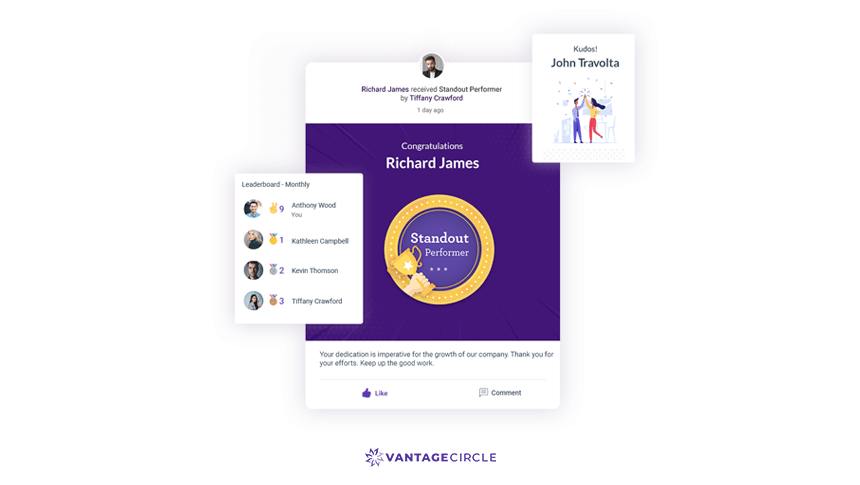
Some unique features that Vantage Rewards boast of are a global point-based rewarding system, social recognition feed, feed engagement score, on-the-spot recognition, cross-platform integrations, automated appreciation, dedicated apps, and more.
Click here to schedule a free demo for Vantage Rewards.
Strategy 2: Personalize the process of appreciation.
The meaningfulness of the appreciation lies behind the person being recognized, whether it is public or private.
Thanking the employee directly for their assistance and hard work throughout the change process is often the most meaningful way to express gratitude. Private or casual one-on-one chats can be a very effective way to recognize both results and the effort put forward by the employee.
Strategy 3: Meaningful Rewards
Rewards may be monetary, but they do not always need to be. What matters most is understanding what types of rewards are meaningful to the people being rewarded.
You can also use rewards to reinforce change by offering them to your employees when they achieve a certain goal. Suppose you offered a reward or bonus early in the change process to boost motivation. In that case, it is critical to honor that commitment even when the targets are met.
Vantage Rewards' comprehensive reward redemption platform offers a variety of reward redemption options, including gift cards, merchandise, experiences, and a wide-range of service milestone awards.
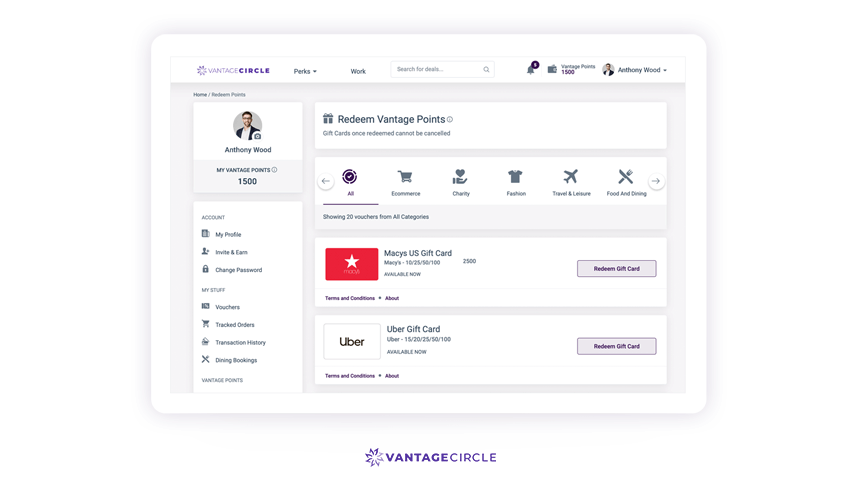
Strategy 4: Employee Feedback
To determine whether your change management activities are achieving their intended goals, you must solicit feedback from key personnel.
Simply asking employees how they adjust to the change gives them a chance to express their progress and allows you to spot any problems affecting them.
The most common practices to gather feedback is through interviews, focus groups, and surveys. But, whatever tools and channels you use, employee feedback helps the leadership team understand where the change is succeeding and where it is failing.
At Vantage Circle, we understand how important employee feedback is in enhancing the employee experience. That is why we put our years of experience into designing a survey tool— called Vantage Pulse— that helps HRs admins study trends, identify reasons for employee attrition, forecast behaviors, and ultimately improve employee retention.
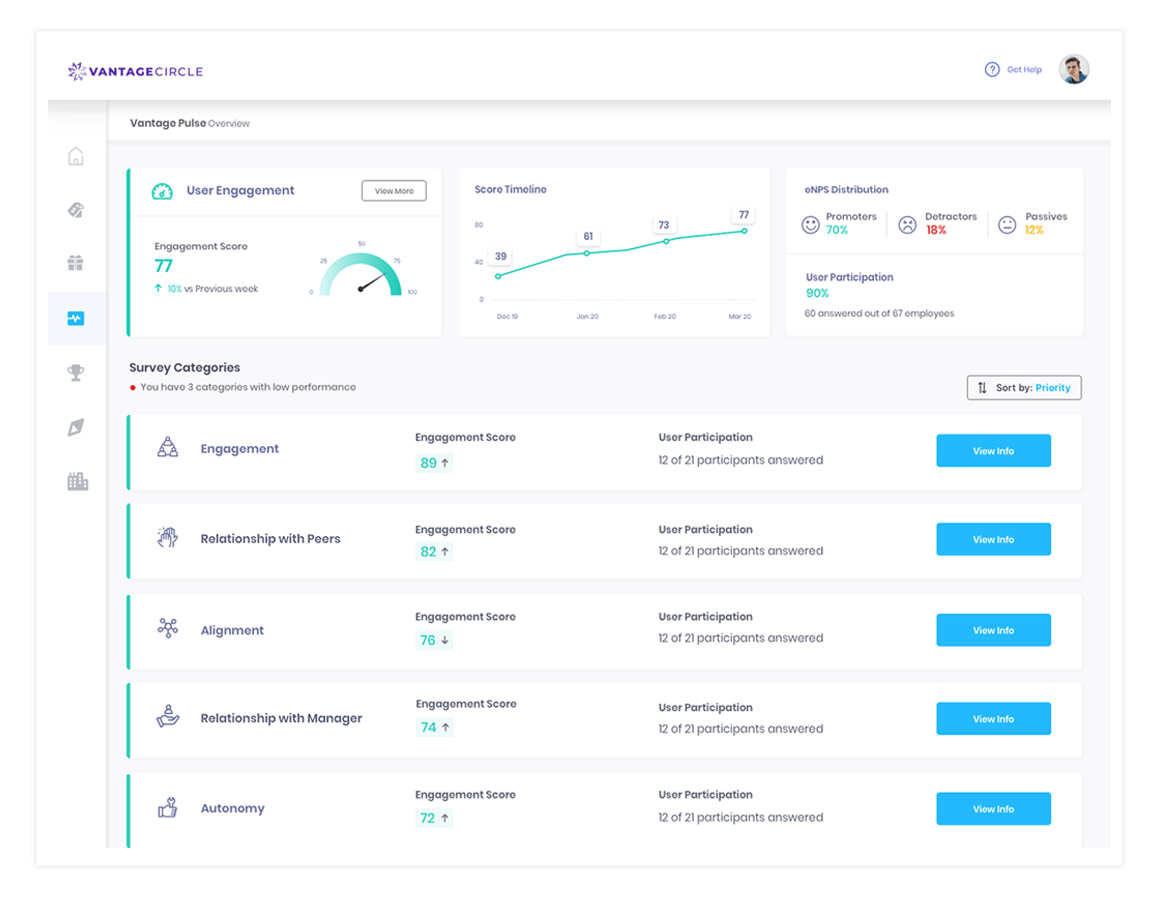
Vantage Pulse is a powerful eNPS-based survey tool that sends out timely surveys that employees can complete in 5 minutes or less. It guarantees that your employees take the surveys seriously and rarely face survey fatigue.
Click here to schedule a free demo for Vantage Pulse.
Strategy 5: Effective Performance Management
A change leader can tell if a change is taking hold by conducting formal assessments and analyzing performance data.
When properly used, performance audits can provide data on:
- How many employees are embracing the change?
- How many are finding it difficult to adjust?
- And what the main issues may be if the change adoption rates are low.
Strategy 6: Accountability Systems
Creating systems for accountability is a powerful approach to drive ongoing reinforcement. If a change is to be sustained over time, it must start with the management and their daily operations.
Data show that 82% of managers admit they have "limited to no" success in holding others accountable. While 91% of workers state that one of their company's top leadership-development needs is "effectively holding others accountable."
By incorporating accountability into the corporate structure, the change team transfers ownership to operational managers, who become in charge of the change and its ongoing success.
How To Get Your Employees Onboard A Change Initiative?
Leadership teams that neglect to prepare for the human side of change frequently wonder why even their best-laid plans fail.
In their seminal book, Switch: How to Change Things When the Change is Hard, Dan Heath and Chip Heath outline a methodology for instilling behavioral change.
Chip and Dan claim that people's brains constantly operate on two separate systems.
- The Rational Side: It is reflective. It thinks, analyses, and plans for the future.
- The Emotional Side: It is instinctive and experiences both pleasure and pain.
They call it "The Rider, The Elephant, and the Path."

It is worth noting that they based it on the work of Jonathan Haidt, a renowned NYU psychologist.
Consider the rational side of the brain to be the Rider and the emotional side to be the Elephant.
- The Rider excels in planning and thinking. Without a strategy, there is no way to do anything.
- Emotion is the Elephant's greatest asset. Without emotion, there would be no drive or energy to accomplish goals.
To change behavior (whether our own or that of others), we must do three things:
Direct The Rider (Make The End Goal Crystal Clear)
The Rider has its own set of problems. A Rider prefers to think about and analyze information before making a decision. When a Rider is unsure which way to go, they lead the Elephant in circles. What appears to be resistance is frequently a lack of clarity.
Motivate the Elephant (Make People See Why The Change Is Needed)
When a person's Elephant disagrees with the direction the Rider wishes to take, the Rider will lose. Through careful observation and self-control, The Rider may briefly prevail. However, the Elephant will always be stronger in the long term than the Rider.
Why does this happen? Because self-control is a finite resource. What appears to be resistance is actually exhaustion. Motivation gives the Rider the energy she needs to maintain self-control. A lack of motivation may doom a change effort.
Shape the Path (Make The Required Changes Specific)
In order to influence the Rider and inspire the Elephant, we must focus on the status quo (including the immediate environment) to increase the likelihood that a change will occur.
Specificity sharpens the focus. It increases the likelihood that the Elephant and the Rider will continue moving toward the goal together. Most often, what appears to be resistance is merely a lack of direction.
Best Practices for Leading Change

Achieving the objectives of a change is not an overnight phenomenon. Change leaders need patience and resilience to see the effects of their change strategies over time. However, despite all these factors, there are certain ways through which you can accelerate the pace of change and make the transition easier for your people. Here's how.
1. Provide Information

For employees to create informed decisions and effective plans, they need all the help and information they can get. When you have new information, share it. What you already know, what you don't, and when to expect updates.
2. A Positive Attitude Helps
As the leader, you serve as the compass of your team. That means your people look up to you whenever they feel unsure about how they feel about a situation. Exhibit an impartial and receptive attitude, even if you are not yet entirely on board with the change.
Research by Emma Seppälä and Kim Cameron found that there is usually one person at the center of workplace networks responsible for most of the forward motion, exceptional performance, and well-being of everyone else. These leaders are known as positive energizers.
3. Bring A Sense Of Normalcy
Even if you are going through a change, never totally ditch the team's rituals. Focus on team goals, facilitate support, monitor performance, and celebrate accomplishments.
4. Delegate And Reassign Roles

Restate your appreciation for each team member and your desire for them to stick with the new direction. Continue delegating work tasks and give employees more say in day-to-day decisions as needed. Consider an employee's current emotional stage, level of experience, capability, and task when determining the appropriate level of authority to assign.
5. Empathize
Show compassion. Helping employees reframe their emotional reactions to the change will enable them to handle their barriers easily. Meanwhile, avoid isolating yourself. To feel supported, employees must have access to you. Use the workforce's cues to determine when to get more involved and when to step back.
6. Take A Structured Approach
Establish short-term goals, time frames, priorities, and standards to assist your team in regaining balance.
7. Meaningful Recognition

It is especially important during times of change to express timely, frequent, and value-based appreciation and provide feedback for work well done.
8. Update Higher Management
Give frank input about the change's effect on the work and the people involved. By doing so, management is guaranteed to have the knowledge required to make wise judgments.
9. Manage Expectations
Be realistic in your optimism. Recognize when circumstances are challenging. Employees react to situations differently, so don't anticipate that they will all react similarly to the change.
10. Practice The 4 Vs

This is not a stand-alone change strategy. Rather, it is a part of a more comprehensive plan (or a tool) to be used as soon as the change is live.
- Visibility: During this period, make yourself available, visible, and involved with your staff.
- Variability: Allow for different personal reactions and give employees more flexibility at work.
- Ventilation: Allow employees to tell their stories, compare reactions, and express their feelings through formal and informal communication channels.
- Validation: Thank employees and acknowledge their efforts. Meaningful recognition and verbal praise can go a long way in difficult times.
Conclusion
Unless you treat organizational change management like a battle that demands a structured approach to win, it is pointless to continue. Every step in an organizational change management strategy must be perfected, carefully planned, and implemented.
For leaders, it might involve re-training themselves to be better change leaders. Still, the results will surely be worth the trouble.

















